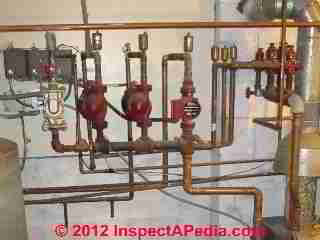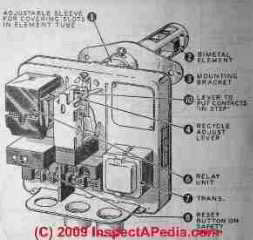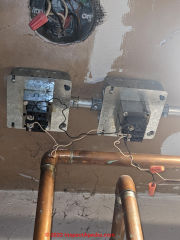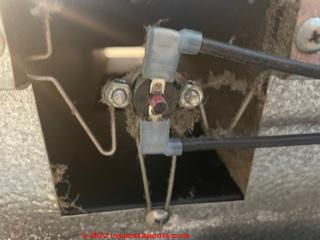 Troubleshoot Low Voltage Transformers for Heating & Air Conditioning Systems
Troubleshoot Low Voltage Transformers for Heating & Air Conditioning Systems
- POST a QUESTION or COMMENT about wiring & testing low voltage transformers for HVAC equipment like air conditioners or heaters & in low voltage wiring systems
Low voltage (12-24 VAC) transformers diagnostic, installation & repair guide for HVAC & lighting systems:
This article explains how low-voltage transformers are used on heating, heat pumps, & air conditioning systems to provide power for thermostats, zone valves, and other relays and controls.
We explain how a low voltage transformer is installed and wired, where the device is usually located, and how to test or troubleshoot & repair low voltage transformers using a VOM or DMM.
InspectAPedia tolerates no conflicts of interest. We have no relationship with advertisers, products, or services discussed at this website.
How to Troubleshoot Low Voltage Transformers for Heating & Air Conditioning Thermostats
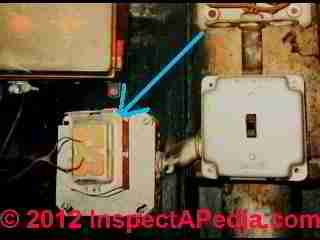 Question: How do you tell if a transformer is bad? How do you test a low voltage transformer?
Question: How do you tell if a transformer is bad? How do you test a low voltage transformer?
How do i tell if a transformer for thermostat is bad ?- Erwin 5/12/12
How do you test a low voltage transformer? - Den 7/16/12
Reply: how to test a low voltage transformer for heating or air conditioning
Erwin if you disconnect the low voltage wires connected to the transformer terminals and use a VOM you should find voltage, usually 14V. If the device looks burned, hot, or smells, don't even bother testing. If it has been buzzing that's another clue.
Den,
Remove all of the the low voltage wires from the two (or more) screws on the top of the transformer. Usually you'll see a small gauge red and white wire simply connected under two screws on the upper surface of the transformer itself.
Some heating transformers for thermostats that use more than two wires will have more than two screws and more than two low voltage wires connected or there may even be multiple sets of thermostat wires connected if the transformer is powering more than one room thermostat. (photo above left).
Check for output voltage: with power to the transformer "on", using the VOM on a low voltage scale (say 0-24VAC ) check for voltage between the two screw terminals.
If the transformer itself is receiving 120V power but there is no voltage between the two low voltage output screws, then it is not working.
To test for a bad low voltage transformer you simply need a volt-ohm meter or a digital VOM.
See DMMs VOMs SAFE USE OF for advice on how to use a volt-ohm meter,
and
see TEST EQUIPMENT, ELECTRICAL GUIDE for advice on how to electrical test equipment safely. And of course you'll have to be sure you have found and are testing the right low voltage relay, as we will explain in the details below.
In our photo you can see a low voltage transformer mounted onto a 4-inch electrical box that is in turn secured to (and powered from) a gray-covered electrical panel. But as there are four circulator pumps shown in the photo, you can figure there will be more LV transformers and more circulator relay switches nearby, connected to other room thermostats in this building.
Why? A typical residential-grade low voltage transformer cannot handle the total current draw (in Amps) to support multiple circulator pump relays or other controls.
Variation in Output Voltage from Low Voltage Transformers
Reader Question: 11/24/2014 john said:
Shouldn't a 24v transformer put out 24V? I'm trying to install a nest thermostat but only getting 18V (apparently it needs at least 20) from a brand new transformer.
Reply:
John,
Low voltage transformers convert 50Hz or 60Hz (cycle) line voltage (120 to 240V) AC (alternating current) to low voltage typically 12, 18, or 24 volts AC at a high frequency Hz, possibly as high as 20 to 50KHZ, that's 20,000 to 50,000 Hz.
There are other common low voltage output levels, for example 5-6V AC on many device chargers and there are also voltage converters that may produce DC rather than AC current.
What that means to you is that before replacing your possibly defective low voltage transformer there are some things to check:
- Check the equipment low voltage requirement specifications
on your HVAC system or low voltage lighting or other low voltage equipment controls to see what voltage is required. Also confirm that you are using the proper type of low voltage transformer or power adapter. For example, if the equipment being powered requires 5VDC don't use a low voltage transformer or power supply providing AC. - Look at markings on the low voltage transformer
itself to see its output rating. Yours might be an 18V unit. - Check the power connections to the low voltage transformer:
Check that the input wires (normally heavier gauge wires) to the transformer are properly connected to the line voltage supply (typically 120V or 240V in most buildings). Check that the output or low voltage terminals on the low voltage transformer are connected to the low voltage wiring. - Measure the output voltage at the low voltage transformer
(using a VOM or DMM) after removing the low voltage wiring that was connected to it - thus eliminating any effects of the wiring itself. Most HVAC thermostats and controls operate at 24VAC. Low voltage lighting systems typically operate at 12V or 24V but other equipment or systems may require different voltage levels.
Note: For a typical magnetic LV transformer used on HVAC systems a typical DMM or VOM will work adequately. But Pegasuslighting.com warns: "Since most voltmeters give misleading readings when applied to high frequency currents the voltage on an electronic low voltage transformer can be measured only by using a "true RMS" voltmeter with a sufficient range." - Determine the type of low voltage transformer you are using:
electronic low voltage transformers may not behave identically to magnetic low voltage transformers.
For a typical 18-24V transformer used on HVAC equipment, the LV transformer is a traditional magnetic type.
But if you are using an electronic low voltage transformer instead of a traditional magnetic low voltage transformer, the high frequency but low voltage produced by the transformer can leave the circuit vulnerable to a more significant voltage drop that occurs on the lower-frequency higher voltage wiring in the building. - Check the low voltage wiring:
With the low voltage wires disconnected from both the low voltage transformer and from their control-end, check the wires for shorts or breaks. Also note that if you are using very small gauge wires or a very long wiring run, depending on the power (watts) load on the circuit there could be a voltage drop.
Pegasus lighting (pegasuslighting.com) points out that "there can be a substantial voltage drop if the wires carrying the high-frequency current are long, thin, or far apart." - Check the line voltage level
to be sure it's within specifications at the source of power to the low voltage transformer, typically 120V in residential buildings.
How your low voltage thermostat and its low voltage transformer work & how they are wired
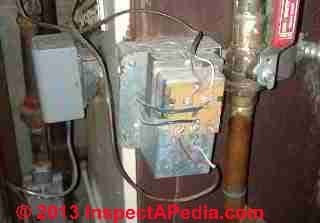
It's usually pretty simple to understand the wiring and function of a low voltage relay on HVAC/R equipment.
The low voltage transformer changes (transforms) house current (at 120V AC) to a lower voltage (usually around 14V to 24V AC) used to operate the room thermostats and possibly other heating or air conditioning controls.
The low-voltage transformer shown at left, a reader-contributed photo, is feeding two pairs of low voltage 24V circuit wires (red and white); the 120V power wires feeding the transformer are the heavier wires in the center of this device. Click to enlarge this or any image.
So the transformer has 12V wires connected to its input terminals (not visible in our photo at left as by code the 120V wires have to be inside of that 4" metal electrical box). The low voltage thermostat wires that bring operating current (14-12V VAC) to the thermostats are on the exposed surface of the transformer.
In the simplest applications, two wires, typically red and white, are connected at the transformer.
A "C" or common terminal wire on the low voltage transformer is connected to the control relay that operates the heater or air conditioner, and
an "R" terminal on the transformer is connected first to the thermostat (which acts as an "on-off" switch) and from the thermostat onwards to a thermostat terminal found on the heater or air conditioner's primary control or circuit board.
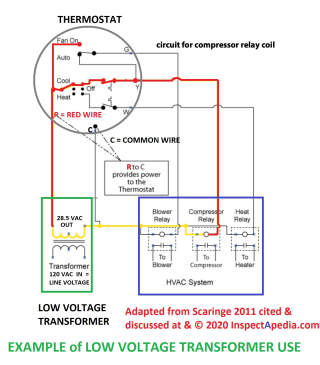 In HVAC installations such as air conditioners, heat pumps, and heating systems, you'll find that a red wire is used to connect between the R or LOAD terminal at the low-voltage transformer and the R terminal at the thermostat.
In HVAC installations such as air conditioners, heat pumps, and heating systems, you'll find that a red wire is used to connect between the R or LOAD terminal at the low-voltage transformer and the R terminal at the thermostat.
HVAC system Transformers: Details about thermostat wiring and low voltage control wiring for transformers used on heating and air conditioning circuits are found
at THERMOSTAT WIRE CONNECTIONS.
Low Voltage Lighting / Receptacle Switching System Transformers: Details about thermostat wiring and low voltage control wiring for transformers used in low voltage lighting control systems are
at
Reader Question: how many devices can a standard 24VAC transformer support?
2016/03/16 Peader said:
I have a 40 year old house that has been remodeled over the years with additional multiple heating zones, modernized thermostats with wireless computer access, intercom, etc. My 24vac control transformer has started buzzing very loudly and I plan on replacing it.
With this new demand on the 24vac side should I consider increasing the existing transformer capacity of 40VA to something larger? Is there a way to determine the output capacity of the transformer?
Reply:
Thanks for the question Peader.
For other readers, 'VA' stands for Volts x Amps. Volts multiplied by Amps is also the classic definition of a Watt. If you hook up more devices drawing more current than a transformer can provide, it'll burn up - fail.
Also to be clear for other readers, the OUTPUT VOLTAGE of a replacement transformer should not be changed - that is if you are running 24VAC devices you want 24VAC supplied by the transformer. You wouldn't change to a 12VAC transformer (for example).
Here is a typical 24VAC transformer product specification using Robertshaw data as an example:
Class 2 Transformer, 40 VA Rating, Input Voltage 120VAC, Output Voltage 24VAC, Multi Mounting, Protective Device Fuse, Primary Connection 8 In. Leads, Secondary Connection 8 In. Leads, 1 Phase, 50/60 Hz, Not Rated Temp. Rise, Open Enclosure Type, Enclosure Rating NEMA 1, Enclosure Finish Bare Steel, Height 2.75 In., Depth 3.25 In., Width 2.44 In., Standards UL 1585 File Number E110657, E92807, E99697, CSA File Number LR107325-1, NEMA
A 24VAC transformer rated for 40VA (volt-amps) means that it can support 40 / 24 = 1.6A or 1.6 amps of current draw (load). That is its output capacity and the answer to your question.
Add up the current requirements (amps) of the devices you want to support. E.g. one zone valve might want 0.3 Amps. so the most you'd put onto one 40VA transformer would be 4 such zone valves - though I've seen a few working installations at which five or even six zone valves on a single transformer.
The VA rating of the transformer should be greater than the load of all the devices connected to it.
So how did they get away with wiring so many zone valves onto one transformer? Luck. Usually not all of the zone valves are being turned "on" by their respective thermostats at the same moment.
During activation the zone valve motor runs for less than a minute.
But eventually, on a very cold night, and with bad luck, all five or six thermostats try to turn on all five or six zone valves at the same time. Maybe the homeowners came back to a cold house and ran amok turning up all of the thermostats in the course of a minute. Hiss. Buzz. Dead transformer.
Typically an older wiser, HVAC installer adds additional transformers rather than installing one giant one serving everything in the house.
That can also avoid having to snake long runs of low voltage wire - depending on where your various devices are. For example an installer hooking up 6 zone valves would install two 24VAC 40VA transformers and wire 3 zone valves to each.
I'd guess that your wireless computer access is talking to a wireless router that is plugged into a 120VAC wall receptacle so that ought not be a concern.
I've hooked up three NEST thermostats in a test building, all working just fine off of the original transformer that originally supported the old Honeywell round units.
See NEST LEARNING THERMOSTATS - the manufacturer probably took care to be sure that their new product would work in older homes without requiring homeowners to change out their thermostat transformer or add additional ones.
Usually an intercom system has its own separate transformer as does a traditional home doorbell and as does the receiver for a remote operated garage door operator.
Testing the Low Voltage Heating or Air Conditioner Transformer
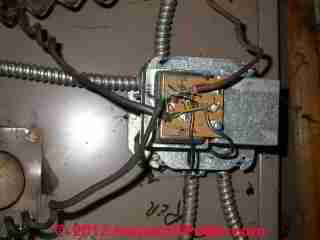
When we think that there may be a problem with getting power to a thermostat (if it needs power) or to other low-voltage-operated controls in an HVAC system, the "test" of the low voltage HVAC transformer involves these very simple steps:
- Find the low voltage transformer
that is operating the thermostat or other control device. Usually the transformer is visible, mounted on an electrical box in the utility area where the heater or air conditioner blower unit is installed (blue arrow in our photo, above left), may be mounted inside of the furnace or air handler itself (photo at left).
On some modern HVAC equipment the low voltage transformer may be harder to spot as it may be incorporated into a more complex circuit board or component.
In all cases, however, if you follow the small gauge low-voltage wires from your thermostat back into the furnace or air handler cabinet you can find wires of this same dimension connected to a transformer.
- Check that all of the wires and connections
are in fact intact, un-damaged, and properly connected. If you suspect that a thermostat wire has been damaged between the transformer and the thermostat, you can try a simple continuity test - disconnect the thermostat wires and connect them together at one end of the run - then test for continuity between the wires using a VOM at the other, disconnected end of the pair. - Check that the low voltage transformer is is providing power
using a VOM we test for voltage between 12-24V AC at the transformer's output screws. Here are the procedural details for testing a low voltage transformer for live output power:
Remove all of the the low voltage wires
from the two (or more) screws on the top of the transformer. Usually you'll see a small gauge red and white wire simply connected under two screws on the upper surface of the transformer itself.
Some heating transformers for thermostats that use more than two wires will have more than two screws and more than two low voltage wires connected or there may even be multiple sets of thermostat wires connected if the transformer is powering more than one room thermostat. (photo above left).
Check for output voltage
with power to the transformer "on", using the VOM on a low voltage scale (say 0-24VAC ) check for voltage between the two screw terminals. If the transformer itself is receiving 120V power but there is no voltage between the two low voltage output screws, then it is not working. - Listen for buzzing
Also before a low voltage transformer fails you may hear it buzzing - a condition that can continue for some time but ultimately is likely to lead to failure. - Inspect for overheating or burn up Finally, by visual inspection you MIGHT see burn marks or evidence of overheating - but I wouldn't depend on visual inspection alone.
Reader Comment: Buzzing low voltage transformer
(Mar 3, 2015) Raymond Rackley said:
Thank you for this website. I learned so much about what I have been trying to say to every electrician that has come to solve the problem of buzzing/vibrating transformers. They all say it's normal but when it keeps waking you up when the thermostat calls for heat in the middle of the night, it is far from normal.
You have taught me to stick to my guns and hire someone who will listen and understand that I have already found and isolated the problem.
Now I just need them to either replace the transformer or check the thermostat that just clicks at will. Thank you for breaking things down in English to a novice in heating and electricity.
Now I need a service technician.
List of Low Voltage Transformers Found on HVAC/R Equipment and in Other Building Applications
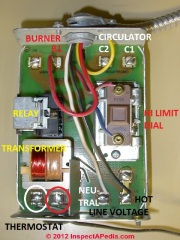
Watch out: there may be more than one low voltage thermostat, for example one controlling heating and another controlling air conditioning in your building.
Or there may be additional low-voltage thermostats providing power to individual hydronic heating zone circulator pump relays and to the thermostats that control each of those zones (see our photo at the top of this page).
Watch out: there are other low voltage transformers found on air conditioners, boilers, furnaces, circulator relays, fan relays, etc. that are not the units providing low voltage to the room thermostat and main on-off HVAC/R controls.
- Primary control LV transformer: The low voltage transformer found inside of a heating boiler primary control and used to operate circulator or other relays (transformer visible at lower left in our photo at left). The low voltage transformer shown in the lower left in this photo of a primary control is not the thermostat power supply.
Other primary controls used on hydronic heating systems and boilers may have two of these relays, one for the oil burner circuit and one for a circulator pump.
In our photo you can indeed see two thermostat control wires connected to the two screws marked "T" just below the LV relay. Those thermostat wires are carrying the "on-off" signal from the room thermostat.
The relay itself operates a 120V relay found just above the LV transformer (center left on the control board) that is used to switch the heating boiler oil burner on or off.
- Low voltage transformer operating one or more hot water heating circulator relays.
The transformer in the primary control of most heating boilers also operates one circulator pump.
But in a building with multiple hydronic heating zones that use individual circulator pumps, each additional circulator pump, presumably serving an individual heating zone, will be turned on or off by the room thermostat located in the zone the circulator pump serves. (see our photo at the top of this page).
In our photo at left, you can see at center three red circulator pumps (two different models have been installed). At the upper left corner of the photo in those gray Honeywell labeled control boxes are individual circulator pump relay controls, each of which will be activated by an individual thermostat.
We can see that we have a gas fired hydronic heating system boiler with three zones, but we don't know from the photo if all three are heating zones - one of those relays and circulators could be supplying heat to an indirect fired water heater.
See Circulator Pumps & Relays and
also INDIRECT FIRED WATER HEATERS for details.
- Cad Cell Relays Low voltage transformer operating the oil burner circuit inside of a cad cell relay. Details are
at CAD CELL RELAY SWITCH. - Doorbells
See DOORBELL troubleshooting - Draft Inducer Fans Low voltage transformer operating the control for a draft inducer fan found on flue vents on some heating equipment.
See DRAFT INDUCER FANS - Stack Relays Low voltage transformer in a stack relay or protectorelay that operates an oil burner - schematic at left. This control is detailed
at STACK RELAY SWITCH - AUTOMATIC VENT DAMPERS On heating equipment
- LOW VOLTAGE BUILDING WIRING that controls lights, electrical receptacles
- ZONE DAMPERS in forced warm air or cooling systems
- ZONE VALVES, HEATING On multiple zone hot water or hydronic heating systems
- Many other relays, solenoids, and devices that operate equipment found in buildings
Reader Comments, Questions & Answers About The Article Above
Below you will find questions and answers previously posted on this page at its page bottom reader comment box.
Reader Q&A - also see RECOMMENDED ARTICLES & FAQs
On 2022-10-13 InspectApedia-911 (mod) - Weil McLain boiler with Nest thermostat
@Keith, to Transformers would certainly be sufficient power for thermostats and Zone valves. I would check first for a wiring error.
On 2022-10-11 by Keith
4 zone well McLain boiler.. I installed nest thermostats with a power adapter for the nest . 2 zones work fine.. now the kitchen will. Only. Turn on when the basement is on.. if the basement is off the kitchen will not work or call.. now the picture.
Is the 2 transformers that supply these zone valves.. do these need to be upgraded to bigger ones.. all. Wiring is correct as the other 2 work fine.
On 2022-07-13 by InspectApedia-911 (mod)
@Ronald J Kienle,
That sure sounds like the same problem we ran into
On 2022-07-12 by Ronald J Kienle
@InspectApedia-911, Thank you for the reply. That is my first order of diagnosis now. My thermostat was wired 50 years ago with two strands of telephone wire so the colors are wrong.....and too short...and mangled from being in a old Honeywell round mercury switch type thermostat so I am going to use some B-connectors to add a foot of new wire with fresh straight ends and rewire the nest.
The other day when I disconnected the wires and then reinserted them as per instructions from Google tech support I had a terrible time getting them to stay in. If that does not do the trick I will reinstall the old Honeywell round unit that I kept and run it for a few days to see if the issue goes away.
Once I determine the issue I will probably rewire the whole thing with a 5 wire system and a common wire.
On 2022-07-12 by InspectApedia-911 (mod) - is the wiring or the transformer the issue
@Ronald J Kienle,
It's an interesting question.
Haven't seen Transformers fail in a way that gives a intermittent power loss but I have seen that problem with loose electrical connections so you might want to double-check all of your wires. Recently at a home in northern Minnesota we had to discontinue using a thermostat (this was not a Nest thermostat) when we found that it's connectors simply would not hold the end of the copper wire securely.
On 2022-07-12 by Ronald J Kienle
Can a faulty LVT cause the AC to cycle off then immediately back on because the target temp has not been reached? I am trying to determine if this issue is my Nest Thermostat or not.
Sometimes, like several times a day, the AC shuts off but then turns right back on because it has not reached the target temp. I am trying to determine if something in the wiring or if the transformer is the issue.
If the power wire to the thermostat lost power for just a moment would it cause this issue....and is it possible for a LVT to act this way. Thanks
On 2022-06-02 by InspectApedia-911 (mod) - reset switch of Williams gas furnace
@RJ,
Thanks so much for posting that "No Heat after New Thermostat Installed" diagnosis and solution, RJ.
What gets confusing is failure of the furnace to start after replacing the thermostat when the problem is traced to a surprise: a thermal reset switch or flue gas spill switch that tripped.
I'm not sure (without a sharper photo without those dust clots (that could be a problem themselves)) if yours is a thermal switch or a flue gas spill switch.
But if you get more nuisance tripping see FLUE GAS SPILL SWITCH TRIPPING & RESET
and see the snap disc limit controls at
FAN LIMIT SWITCH INSTALLATION & WIRING
On 2022-06-02 by RJ
Super helpful info on this page to troubleshoot my problem. Replaced old analog thermostat with new digital one on hallway Williams gas furnace. New ts would not work ! Wires good, connections good. If I jumped it at furnace it would come on full blast.
Opened it up to check transformer. Found a 'reset' switch wired up high inside furnace. Pressed that, tried again at thermostat and walaaa! Heat! Hope this helps someone.
Picture is of reset switch in upper left side of Williams hallway type gas furnace.
On 2021-11-27 by Inspectapedia Com Moderator
@Hugh Campbell,
Well I have seen failing transformers drop voltage an cause a burner to fail, but that was on oil burners - a much different (high) voltage requirement.
A transformer is cheap to replace as a try.
But you know, you can install a new thermocouple flame sensor but if it's not placed perfectly in the flame or if the flame itself is weak, the heater's safety feature will shut it down.
Another thermocouple mistake I've made was not screwing the other end of the tubing fully into the gas valve - giving intermittent "no-flame" reports even though the flame was good.
On 2021-11-26 by Hugh Campbell
@Inspectapedia Com Moderator, I replaced the flame sensor before I replaced the gas valve. After replacing the flame sensor, I checked voltage at the gas valve and still had 25.2vac at the gas valve solenoid when the flame went out.
That was the reason I replaced the gas valve. But the flame even with new flame sensor and gas valve goes out after about 15 seconds.
It's a three try control before no flame code. But will light five to six times before setting no flame fault.
On 2021-11-23 by Inspectapedia Com Moderator - Coleman furnace won't stay lit
@Hugh Campbell,
more-likely- at least what I'd replace first, is the thermocouple
On 2021-11-23 by Hugh Campbell
Coleman furnace. 120v - 24v transformer. I get ignition and after about 15 seconds flame drops out. I checked voltage at gas valve as unit lit 25.2vac. Still had 25.2vac until flame was out.
Flame sensor was reading that flame was present.
Replaced gas valve. Same issue. Is it possible the transformer is the issue.
On 2019-03-03 by (mod) - When I disconnect it at the water heater the furnace won't run
Vic
I'll be glad to assist but we first need to get an accurate understanding of the situation.
If you had a separate oil-fired water heater with its own oil burner and controls, there would be no connection whatsoever to a home heating furnace (forced warm air heating system).
If your home heating system was a hot water boiler (and radiators or baseboards) that was also heating an indirect-fired hot water tank and that is what you abandoned, then indeed a thermostat at the hot water tank would have called for a circulator to run to re-heat the tank with hot water from the heating boiler.
It would have appeared as a separate heating zone as far as the home heating boiler was concerned.
Search InspectApedia.com for INDIRECT WATER HEATER to read details of how those heaters are hooked up and operated.
Assuming you meant home heating boiler (and used the word "furnace" generically), you'd remove all wires and controls that previously connected the heating boiler to the indirect fired water tank.
Then review the aquastat settings on your heating boiler and the thermostats in your home.
Or see these two diagnostic articles
NO HEAT BOILER - for hydronic (hot water) heating systems
NO HEAT FURNACE - for forced air heating systems
On 2019-03-03 by Vic P.
Hi, We replaced a oil hot water heater with an electric tank. In decommissioning the tank to remove it, I capped/plugged the chimney/stack pipe at the 'Y', capped the oil line 'T' fitting with a flare nut and disconnected the 120V cable to the tank. The problem I am up against is the 2 wire low voltage line that goes from the oil furnace to the tank.
When I disconnect it at the water heater the furnace won't run. How do I terminate that low voltage line ?
On 2017-12-10 - by (mod) -
Sorry Gene, I have this trouble too - sometimes I forget where I posted a question.
Your original question was posted at the bottom of ZONE VALVE WIRING
By luck I spent a sickening amount of time working on adding information and illustrations to your question and my reply this evening.
You can find all of that information repeated and possibly expanded a bit ALSO at this FAQs page:
ZONE VALVE WIRING FAQs
What I do is use the InspectApedia on-page search box to try a search for words I can remember from a question or comment. Google will (below some ads) return the most-likely or best matches and one of those is usually the article I want.
You can also click the little "email me replies" button under Comments Box though I've not used that and am not sure how well it works.
On 2017-12-10 by Gene 12/8/17
How can I get back to my question from yesterday
On 2017-05-05 by Rick
Some of my low voltage lights are on and will not turn off and some of them are off and won't turn on. I found the transformer and it is hot, hot, hot to the touch. Any idea what is causing all this?
On 2017-02-20 - by (mod) -
Sergio
I may have misunderstood but with power disconnected from a 24VAC transformer I would not expect to read any voltage whatsoever. Perhaps your meter is out of adjustment.
On 2017-02-19 by Sergio
I tested a 24 volt transformer with the power off and it gave me .7 volts is it good or should it give me more volts?
...
Continue reading at LOW VOLTAGE TRANSFORMER, TRANSVERTER DIAGNOSIS or select a topic from the closely-related articles below, or see the complete ARTICLE INDEX.
Or see LOW VOLTAGE TRANSFORMER FAQs - questions & answers posted originally at this page
Or see these
Recommended Articles
- BUZZING NOISE DIAGNOSIS - topic home
- BOILER CONTROLS & SWITCHES
- FURNACE CONTROLS & SWITCHES
- HEAT WON'T TURN OFF
- HEAT WON'T TURN ON
- HUMMING NOISES in BUILDINGS - topic home
- LOW VOLTAGE BUILDING WIRING - home
- COMMON WIRE at THERMOSTATS
- LOW VOLTAGE WIRING SYSTEM COMPONENTS
- LOW VOLTAGE LIGHTING & CONTROL RELAYS
- LOW VOLTAGE TRANSFORMERS, TRANSVERTERS, CONVERTERS
- LOW VOLTAGE TRANSFORMER, TRANSVERTER DIAGNOSIS
- LOW VOLTAGE TRANSFORMER TEST
- LOW VOLTAGE TRANSFORMER WIRING GUIDE
- LOW VOLTAGE WIRING REPAIR or UPGRADE
- LOW VOLTAGE WIRING REPAIR PARTS SOURCES
- THERMOSTAT WIRE CONNECTIONS
- THERMOSTAT WON'T TURN OFF
- THERMOSTAT WON'T TURN ON
- VOLTS MEASUREMENT METHODS
Suggested citation for this web page
LOW VOLTAGE TRANSFORMER TEST at InspectApedia.com - online encyclopedia of building & environmental inspection, testing, diagnosis, repair, & problem prevention advice.
Or see this
INDEX to RELATED ARTICLES: ARTICLE INDEX to ELECTRICAL INSPECTION & TESTING
Or use the SEARCH BOX found below to Ask a Question or Search InspectApedia
Ask a Question or Search InspectApedia
Try the search box just below, or if you prefer, post a question or comment in the Comments box below and we will respond promptly.
Search the InspectApedia website
Note: appearance of your Comment below may be delayed: if your comment contains an image, photograph, web link, or text that looks to the software as if it might be a web link, your posting will appear after it has been approved by a moderator. Apologies for the delay.
Only one image can be added per comment but you can post as many comments, and therefore images, as you like.
You will not receive a notification when a response to your question has been posted.
Please bookmark this page to make it easy for you to check back for our response.
Our Comment Box is provided by Countable Web Productions countable.ca
Citations & References
In addition to any citations in the article above, a full list is available on request.
- Pegasus Lighting, "Low Voltage Transformers FAQs", Pegasus Lighting is a supplier of lighting fixtures, bulbs, power supplies and controls. Tel: Website: www.pegasuslighting.com, - retrieved 11/23/2014, original source: http://www.pegasuslighting.com/low-voltage-transformers.html
Quoting
The output of an electronic low voltage transformer, unless it is a DC low voltage transformer, is high frequency (20,000-50,000 Hertz). This means that there can be a substantial voltage drop if the wires carrying the high-frequency current are long, thin, or far apart. Always follow these rules to avoid a large voltage drop. Use thick wires on the secondary/output side. The thicker the wire, the less the voltage drop you will experience. The shorter the distance between transformer and lamp(s), the less the voltage drop you will experience. Try to use a pair of secondary wires that are twisted together. The closer the two output wires are to each other, the lower the voltage drop you will experience. When a low voltage transformer powers more than one fixture or circuit, split the output of the low voltage transformer immediately into several separate circuits rather than carrying all the power in one pair of wires. The less power per circuit, the less the voltage drop you will experience. That is, a circuit with a total of 300 watts of load will have a greater voltage drop than a circuit with only 50 watts of load. A DC low voltage transformer offers the only electronic solution that overcomes this type of voltage drop issue. - [1] The ABC's of Retention Head Oil Burners, National Association of Oil Heat Service Managers, TM 115, National Old Timers' Association of the Energy Industry, PO Box 168, Mineola, NY 11501. (Excellent tips on spotting problems on oil-fired heating equipment. Booklet.)
- [2] Domestic and Commercial Oil Burners, Charles H. Burkhardt, McGraw Hill Book Company, New York 3rd Ed 1969.
- [3] National Fuel Gas Code (Z223.1) $16.00 and National Fuel Gas Code Handbook (Z223.2) $47.00 American Gas Association (A.G.A.), 1515 Wilson Boulevard, Arlington, VA 22209 also available from National Fire Protection Association, Batterymarch Park, Quincy, MA 02269. Fundamentals of Gas Appliance Venting and Ventilation, 1985, American Gas Association Laboratories, Engineering Services Department. American Gas Association, 1515 Wilson Boulevard, Arlington, VA 22209. Catalog #XHO585. Reprinted 1989.
- [4] Fuel Oil & Oil Heating Magazine, 3621 Hill Rd., Parsippany, NJ 07054, 973-331-9545
- [5] The Steam Book, 1984, Training and Education Department, Fluid Handling Division, ITT [probably out of print, possibly available from several home inspection supply companies] Fuel Oil and Oil Heat Magazine, October 1990, offers an update,
- [6] Principles of Steam Heating, $13.25 includes postage. Fuel oil & Oil Heat Magazine, 389 Passaic Ave., Fairfield, NJ 07004.
- [7] Principles of Steam Heating, Dan Holohan, technical editor of Fuel Oil and Oil Heat magazine, 389 Passaic Ave., Fairfield, NJ 07004 ($12.+1.25 postage/handling).
- [8] "Residential Steam Heating Systems", Instructional Technologies Institute, Inc., 145 "D" Grassy Plain St., Bethel, CT 06801 800/227-1663 [home inspection training material] 1987
- [9] "Residential Hydronic (circulating hot water) Heating Systems", Instructional Technologies Institute, Inc., 145 "D" Grassy Plain St., Bethel, CT 06801 800/227-1663 [home inspection training material] 1987
- [10] "Warm Air Heating Systems". Instructional Technologies Institute, Inc., 145 "D" Grassy Plain St., Bethel, CT 06801 800/227-1663 [home inspection training material] 1987
- [11] Heating, Ventilating, and Air Conditioning Volume I, Heating Fundamentals,
- Boilers, Boiler Conversions, James E. Brumbaugh, ISBN 0-672-23389-4 (v. 1) Volume II, Oil, Gas, and Coal Burners, Controls, Ducts, Piping, Valves, James E. Brumbaugh, ISBN 0-672-23390-7 (v. 2) Volume III, Radiant Heating, Water Heaters, Ventilation, Air Conditioning, Heat Pumps, Air Cleaners, James E. Brumbaugh, ISBN 0-672-23383-5 (v. 3) or ISBN 0-672-23380-0 (set) Special Sales Director, Macmillan Publishing Co., 866 Third Ave., New York, NY 10022. Macmillan Publishing Co., NY
- [12] Installation Guide for Residential Hydronic Heating Systems
- [13] Installation Guide #200, The Hydronics Institute, 35 Russo Place, Berkeley Heights, NJ 07922
- [14] Bob Scaringe, Ph.D., P.E., "Thermostatic Wiring Principles", QwikProducts by Mainstream Engineering, Rockledge FL, Tel: 800-866-3550, Website: http://www.mainstream-engr.com/, retrieved 7/17/2011, original source http://www.epatest.com/store/resources/images/misc/how-a-thermostat-operates.pdf, [copy on file as how-a-thermostat-operates.pdf ]
- [15] Voltage Transformer, U.S. Patent No. 2,412,345, Dec. 10, 1946, Nils E. Lindenblad, Port Jefferson, NY, for Radio Corporation of America
- Our recommended books about building & mechanical systems design, inspection, problem diagnosis, and repair, and about indoor environment and IAQ testing, diagnosis, and cleanup are at the InspectAPedia Bookstore. Also see our Book Reviews - InspectAPedia.
- In addition to citations & references found in this article, see the research citations given at the end of the related articles found at our suggested
CONTINUE READING or RECOMMENDED ARTICLES.
- Carson, Dunlop & Associates Ltd., 120 Carlton Street Suite 407, Toronto ON M5A 4K2. Tel: (416) 964-9415 1-800-268-7070 Email: info@carsondunlop.com. Alan Carson is a past president of ASHI, the American Society of Home Inspectors.
Thanks to Alan Carson and Bob Dunlop, for permission for InspectAPedia to use text excerpts from The HOME REFERENCE BOOK - the Encyclopedia of Homes and to use illustrations from The ILLUSTRATED HOME .
Carson Dunlop Associates provides extensive home inspection education and report writing material. In gratitude we provide links to tsome Carson Dunlop Associates products and services.


